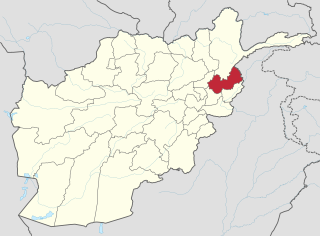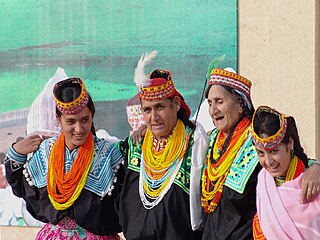Related Research Articles

Brahui is a northern Dravidian language spoken primarily by the Brahui people in the central part of Balochistan Province, in Pakistan and in scattered parts of Iran, Afghanistan and Turkmenistan and by expatriate Brahui communities in Iraq, Qatar and United Arab Emirates. It is isolated from the nearest Dravidian-speaking neighbour population of South India by a distance of more than 1,500 kilometres (930 mi). The Kalat, Khuzdar, Mastung, Quetta, Bolan, Nasirabad, Nushki, and Kharan districts of Balochistan Province are predominantly Brahui-speaking. Brahui is also spoken in Sindh, mostly in Larkana and Nawabshah divisions.

Pakistan's estimated population was 207,774,520 according to the provisional results of the 2017 Census of Pakistan. Pakistan is the world's fifth-most-populous country.

The Indo-Aryan languages are a branch of the Indo-Iranian languages, themselves a branch of the Indo-European language family. As of the early 21st century more than 800 million people speak Indo-Aryan languages, primarily in India, Bangladesh, Nepal, Pakistan and Sri Lanka. Morever, apart from the Indo subcontinent, large immigrant and expatriate Indo-Aryan-speaking communities live in Northwestern Europe, Western Asia, North America, Southeast Africa and Australia, along with several million speakers of Romani languages primarily in Southeastern Europe. There are well over 200 known Indo-Aryan languages.

Pakistan has many dozens of languages spoken as first languages. Five languages have more than 10 million speakers each – Punjabi, Pashto, Sindhi, Saraiki and Urdu. Almost all of Pakistan's languages belong to the Indo-Iranian group of the Indo-European language family.

The Munda languages are a group of closely related languages spoken by about nine million people in India and Bangladesh. Historically, they have been called the Kolarian languages. They constitute a branch of the Austroasiatic language family, which means they are more distantly related to languages such as the Mon and Khmer languages, to Vietnamese, as well as to minority languages in Thailand and Laos and the minority Mangic languages of South China. Ho, Mundari, and Santali are notable Munda languages.

The Nuristani languages, formerly known as Kafiri languages, are one of the three groups within the Indo-Iranian language family, alongside the much larger Indo-Aryan and Iranian groups. They have approximately 130,000 speakers primarily in eastern Afghanistan and a few adjacent valleys in Khyber Pakhtunkhwa's Chitral District, Pakistan. The region inhabited by the Nuristanis is located in the southern Hindu Kush mountains, and is drained by the Alingar River in the west, the Pech River in the center, and the Landai Sin and Kunar rivers in the east. The languages were previously often grouped with Indo-Aryan or Iranian until they were finally classified as forming a third branch in Indo-Iranian.

The Dardic languages are a subgroup of the Indo-Aryan languages natively spoken in northern Pakistan's Gilgit-Baltistan and Khyber Pakhtunkhwa, northern India's Kashmir Valley and Chenab Valley and parts of eastern Afghanistan. Kashmiri is the most prominent Dardic language, with an established literary tradition, alongside official recognition as one of India's 22 scheduled languages.

Khowar, is an Indo-Aryan language of the Dardic group spoken primarily in the Chitral and Ghizer Gilgit region of Pakistan.
Dameli is a Dardic language spoken by approximately 5,000 people in the Domel Valley, in the Chitral District of Khyber-Pakhtunkhwa province of Pakistan.

Kalasha is an Indo-European language in the Indo-Aryan branch spoken by the Kalash people, further classified as a Dardic language in the Chitral group. The Kalasha language is phonologically atypical because it contrasts plain, long, nasal and retroflex vowels as well as combinations of these.

Shina is a language from the Dardic sub-group of the Indo-Aryan family spoken by the Shina people, a plurality of the people in Gilgit-Baltistan and Chitral of Pakistan and a number of people in Ladakh, India, as well as in pockets in Jammu and Kashmir, India, such as in Gurez and Chanderkote.

Bangani is an Indo-Aryan language spoken in parts of Uttarkashi district in the west of the Garhwal region of Uttarakhand, India. It has been described either as a member of the Western Pahari language group, or as a dialect of the Central Pahari Garhwali language. It shares between one half and two thirds of its basic vocabulary with neighbouring varieties of Garhwali and with the Western Pahari languages of Jaunsari and Sirmauri.

Lahnda also known as Lahndi or Western Punjabi, is a group of north-western Indo-Aryan language varieties spoken in parts of Pakistan and India. The main Lahnda languages are Saraiki, Hindko and Pahari/Pothwari. They are spoken in large parts of Pakistani Punjab, in some areas of the Khyber Pakhtunkwa province, throughout Pakistani-administered Azad Kashmir and in the western parts of Indian-administered Jammu and Kashmir.
Vedic Sanskrit has a number of linguistic features which are alien to most other Indo-European languages. Prominent examples include: phonologically, the introduction of retroflexes, which alternate with dentals, and morphologically, the formation of gerunds. Some philologists attribute such features, as well as the presence of non-Indo-European vocabulary, to a local substratum of languages encountered by Indo-Aryan peoples in Central Asia (Bactria-Marghiana) and within the Indian subcontinent, including the Dravidian languages.

Colin Paul Masica was an American linguist who was professor emeritus in the Department of South Asian Languages and Civilizations and the Department of Linguistics at the University of Chicago. Besides being a specialist in Indo-Aryan languages, much of his work was on the typological convergence of languages belonging to different linguistic families in the South Asian area and beyond, more broadly on this phenomenon in general, and on possible explanations for it and implications of it in connection with both linguistic and cultural history.
Hindkowans, also known as the Hindki, are an Indo-Aryan linguistic-cultural group, which is native to the Hazara, Pothohar and Azad Kashmir regions of Pakistan. Hindkowans speak various Hindko dialects of Lahnda.
Sawi, Savi, or Sauji, is an endangered Indo-Aryan language of northeastern Afghanistan. It is classified as a member of the Shina language cluster within the Dardic subgroup.
Jaḍgālī is an Indo-Aryan language spoken by the Jadgal, an ethno-linguistic group of Pakistan and Iran. It is one of only two Indo-Aryan languages found on the Iranian plateau. It is a dialect of Sindhi most closely related to Lasi.
Alice Davison was an American linguist who specialized in the syntax of South Asian languages, in particular Hindustani.
Henrik Liljegren is a linguist and Associate Professor in the Department of Linguistics at Stockholm University. He does fieldwork on languages of northern Pakistan, particularly the Hindukush–Karakoram region, and studies typology of and genetic relations between languages of the region. His most recent project is investigating Language contact and relatedness in the Hindukush region, funded by the Vetenskapsrådet.
References
- ↑ "Online Directory: Elena Bashir". The University of Chicago. University of Chicago. Retrieved December 25, 2020.
- ↑ Bashir, Elena. "Elena Bashir". ResearchGate. Retrieved December 25, 2020.
- 1 2 Heegård Petersen, Jan (September 30, 2015). "Kalasha texts – With introductory grammar". Acta Linguistica Hafniensia. 47 (sup1): 25. doi:10.1080/03740463.2015.1069049.
- ↑ "Board of Trustees". American Institute of Afghanistan Studies. Retrieved December 29, 2020.
- ↑ "Journal of Urdu Studies" . Retrieved December 29, 2020.
- ↑ Hock, Hans Henrich; Bashir, Elena, eds. (January 23, 2016). The Languages and Linguistics of South Asia: A Comprehensive Guide. De Gruyter. doi:10.1515/9783110423303. ISBN 9783110423303.